语言学教程课件2 Speech sounds
- 格式:ppt
- 大小:3.98 MB
- 文档页数:115
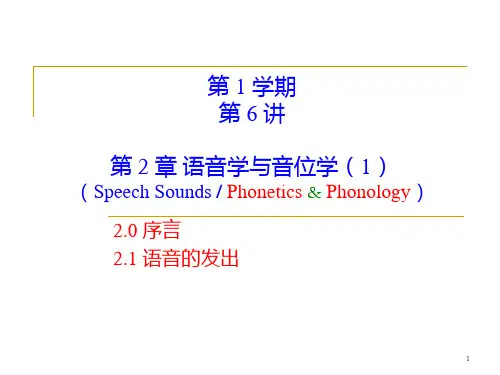
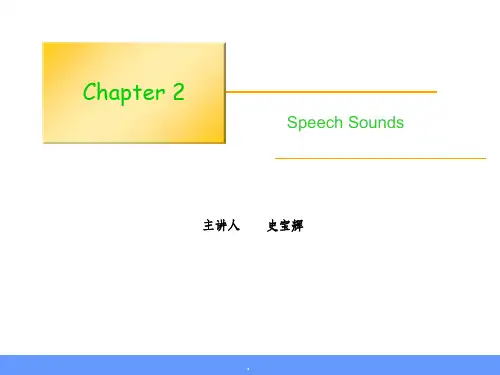
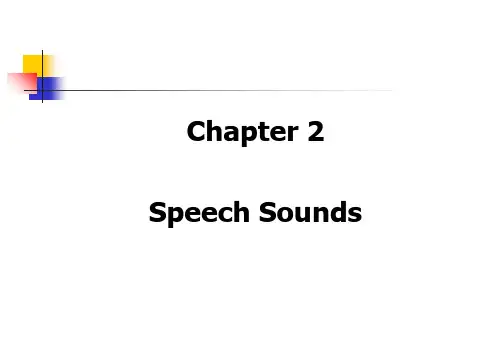
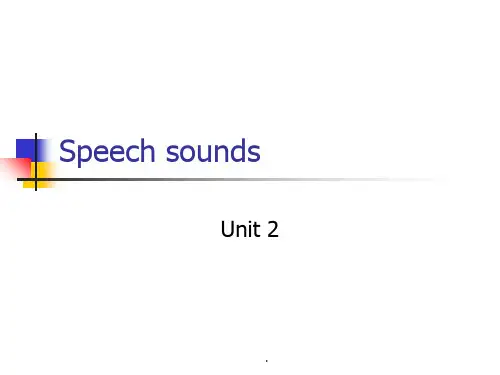

Chapter 2 Speech Sounds2.1 Speech production and perceptionPhonetics is the study of speech sounds. It includes three main areas:1. Articulatory phonetics – the study of the production of speech sounds2. Acoustic phonetics –the study of the physical properties of the sounds produced inspeech3. Auditory phonetics – the study of perception of speech soundsMost phoneticians are interested in articulatory phonetics.2.2 Speech organsSpeech organs are those parts of the human body involved in the production of speech. The speech organs can be considered as consisting of three parts: the initiator of the air stream, the producer of voice and the resonating cavities.2.3 Segments, divergences, and phonetic transcription2.3.1 Segments and divergencesAs there are more sounds in English than its letters, each letter must represent more than one sound.2.3.2 Phonetic transcriptionInternational Phonetic Alphabet (IPA): the system of symbols for representing the pronunciation of words in any language according to the principles of the InternationalPhonetic Association. The symbols consists of letters and diacritics. Some letters aretaken from the Roman alphabet, some are special symbols.2.4 Consonants2.4.1 Consonants and vowelsA consonant is produced by constricting or obstructing the vocal tract at someplaces to divert, impede, or completely shut off the flow of air in the oral cavity.A vowel is produced without obstruction so no turbulence or a total stopping of theair can be perceived.2.4.2 ConsonantsThe categories of consonant are established on the basis of several factors. The most important of these factors are:1. the actual relationship between the articulators and thus the way in which theair passes through certain parts of the vocal tract (manner of articulation);2. where in the vocal tract there is approximation, narrowing, or the obstructionof the air (place of articulation).2.4.3 Manners of articulation1. Stop/plosive: A speech sound which is produced by stopping the air streamfrom the lungs and then suddenly releasing it. In English,[☐ ♌ ♦ ♎ ♑] are stops and [❍ ⏹ ☠]are nasal stops.2. Fricative: A speech sound which is produced by allowing the air stream fromthe lungs to escape with friction. This is caused by bringing the twoarticulators, e.g. the upper teeth and the lower lip, close together but notcloses enough to stop the airstreams completely. In English,[♐ ❆ ♦ ☞ ✞ ♒] are fricatives.3. (Median) approximant: An articulation in which one articulator is close toanother, but without the vocal tract being narrowed to such an extent that aturbulent airstream is produced. In English this class of sounds includes[♦ ❑ ].4. Lateral (approximant): A speech sound which is produced by partiallyblocking the airstream from the lungs, usually by the tongue, but letting itescape at one or both sides of the blockage. [●] is the only lateral in English.Other consonantal articulations include trill, tap or flap, and affricate.2.4.4 Places of articulation1. Bilabial: A speech sound which is made with the two lips.2. Labiodental: A speech sound which is made with the lower lip and the upperfront teeth.3. Dental: A speech sound which is made by the tongue tip or blade and theupper front teeth.4. Alveolar: A speech sound which is made with the tongue tip or blade and thealveolar ridge.5. Postalveolar: A speech sound which is made with the tongue tip and the backof the alveolar ridge.6. Retroflex: A speech sound which is made with the tongue tip or blade curledback so that the underside of the tongue tip or blade forms a stricture with theback of the alveolar ridge or the hard palate.7. Palatal: A speech sound which is made with the front of the tongue and thehard palate.8. V elar: A speech sound which is made with the back of the tongue and the softpalate.9. Uvular: A speech sound which is made with the back of the tongue and theuvula, the short projection of the soft tissue and muscle at the posterior end ofthe velum.10. Pharyngeal: A speech sound which is made with the root of the tongue and thewalls of the pharynx.11. Glottal: A speech sound which is made with the two pieces of vocal foldspushed towards each other.2.4.5 The consonants of EnglishReceived Pronunciation (RP): The type of British Standard English pronunciation which has been regarded as the prestige variety and which shows no regional variation.It has often been popularly referred to as “BBC English” or “Oxford English” because itis widely used in the private sector of the education system and spoken by mostnewsreaders of the BBC network.In many cases there are two sounds that share the same place and manner of articulation. These pairs of consonants are distinguished by voicing, the one appearingon the left is voiceless and the one on the right is voiced.Therefore, the consonants of English can be described in the following way:[p] voiceless bilabial stop[b] voiced bilabial stop[s] voiceless alveolar fricative[z] voiced alveolar fricative[m] bilabial nasal[n] alveolar nasal[l] alveolar lateral[j] palatal approximant[h] glottal fricative[r] alveolar approximant2.5 Vowels2.5.1 The criteria of vowel description1. The part of the tongue that is raised – front, center, or back.2. The extent to which the tongue rises in the direction of the palate. Normally,three or four degrees are recognized: high, mid (often divided into mid-highand mid-low) and low.3. The kind of opening made at the lips –various degrees of lip rounding orspreading.4. The position of the soft palate –raised for oral vowels, and lowered forvowels which have been nasalized.2.5.2 The theory of cardinal vowels[Icywarmtea doesn’t quite understand this theory.]Cardinal vowels are a set of vowel qualities arbitrarily defined, fixed and unchanging, intending to provide a frame of reference for the description of the actualvowels of existing languages.By convention, the eight primary cardinal vowels are numbered from one to eight as follows: CV1[♓], CV2[♏], CV3[☪], CV4[♋], CV5[ ], CV6[ ], CV7[☐],CV8[◆].A set of secondary cardinal vowels is obtained by reversing the lip-rounding for agive position: CV9 – CV16. [I am sorry I cannot type out many of these. If you want toknow, you may consult the textbook p. 47. – icywarmtea]2.5.3 Vowel glidesPure (monophthong) vowels: vowels which are produced without any noticeable change in vowel quality.V owel glides: V owels where there is an audible change of quality.Diphthong: A vowel which is usually considered as one distinctive vowel of a particular language but really involves two vowels, with one vowel gliding to the other.2.5.4 The vowels of RP[♓] high front tense unrounded vowel[◆] high back lax rounded vowel[☜] central lax unrounded vowel[ ] low back lax rounded vowel2.6 Coarticulation and phonetic transcription2.6.1 CoarticulationCoarticulation: The simultaneous or overlapping articulation of two successive phonological units.Anticipatory coarticulation: If the sound becomes more like the following sound, as in the case of lamp, it is known as anticipatory coarticulation.Perseverative coarticulation: If the sound displays the influence of the preceding sound, as in the case of map, it is perseverative coarticulation.Nasalization: Change or process by which vowels or consonants become nasal.Diacritics: Any mark in writing additional to a letter or other basic elements.2.6.2 Broad and narrow transcriptionsThe use of a simple set of symbols in our transcription is called a broad transcription. The use of more specific symbols to show more phonetic detail is referredto as a narrow transcription. The former was meant to indicate only these soundscapable of distinguishing one word from another in a given language while the latterwas meant to symbolize all the possible speech sounds, including even the minutestshades of pronunciation.2.7 Phonological analysisPhonetics is the study of speech sounds. It includes three main areas: articulatory phonetics, acoustic phonetics, and auditory phonetics. On the other hand, phonology studies the rules governing the structure, distribution, and sequencing of speech sounds and the shape of syllables. There is a fair degree of overlap in what concerns the two subjects, so sometimes it is hard to draw the boundary between them. Phonetics is the study of all possible speech sounds while phonology studies the way in which speakers of a language systematically use a selection of these sounds in order to express meaning. That is to say, phonology is concerned with the linguistic patterning of sounds in human languages, with its primary aim being to discover the principles that govern the way sounds are organized in languages, and to explain the variations that occur. 2.8 Phonemes and allophones2.8.1 Minimal pairsMinimal pairs are two words in a language which differ from each other by only one distinctive sound and which also differ in meaning. E.g. the English words tie anddie are minimal pairs as they differ in meaning and in their initial phonemes /t/ and /d/.By identifying the minimal pairs of a language, a phonologist can find out which soundsubstitutions cause differences of meaning.2.8.2 The phoneme theory2.8.3 AllophonesA phoneme is the smallest linguistic unit of sound that can signal a difference inmeaning. Any of the different forms of a phoneme is called its allophones. E.g. inEnglish, when the phoneme /☐/ occurs at the beginning of the word like peak/☐♓/, it is said with a little puff of air, it is aspirated. But when /☐/ occurs in theword like speak /♦☐♓/, it is said without the puff of the air, it is unaspirated. Boththe aspirated [☐♒] in peak and the unaspirated [☐=] in speak have the same phonemicfunction, i.e. they are both heard and identified as /☐/ and not as /♌/; they are bothallophones of the phoneme /☐/.2.9 Phonological processes2.9.1 AssimilationAssimilation: A process by which one sound takes on some or all the characteristics of a neighboring sound.Regressive assimilation: If a following sound is influencing a preceding sound, we call it regressive assimilation.Progressive assimilation: If a preceding sound is influencing a following sound, we call it progressive assimilation.Devoicing: A process by which voiced sounds become voiceless. Devoicing of voiced consonants often occurs in English when they are at the end of a word.2.9.2 Phonological processes and phonological rulesThe changes in assimilation, nasalization, dentalization, and velarization are all phonological processes in which a target or affected segment undergoes a structuralchange in certain environments or contexts. In each process the change is conditioned ortriggered by a following sound or, in the case of progressive assimilation, a precedingsound. Consequently, we can say that any phonological process must have three aspectsto it: a set of sounds to undergo the process; a set of sounds produced by the process; aset of situations in which the process applies.We can represent the process by mans of an arrow: voiced fricative →voiceless / __________ voiceless. This is a phonological rule. The slash (/) specifies theenvironment in which the change takes place. The bar (called the focus bar) indicatesthe position of the target segment. So the rule reads: a voiced fricative is transformedinto the corresponding voiceless sound when it appears before a voiceless sound.2.9.3 Rule ordering[No much to say, so omitted – icywarmtea]2.10 Distinctive featuresDistinctive feature: A particular characteristic which distinguishes one distinctive sound unit of a language from another or one group of sounds from another group.Binary feature: A property of a phoneme or a word which can be used to describe the phoneme or word. A binary feature is either present or absent. Binary features are also used to describe the semantic properties of words.2.11 SyllablesSuprasegmental features: Suprasegmental features are those aspects of speech that involve more than single sound segments. The principal suprasegmental features are syllables, stress, tone, and intonation.Syllable: A unit in speech which is often longer than one sound and smaller than a whole word.Open syllable: A syllable which ends in a vowel.Closed syllable: A syllable which ends in a consonant.Maximal onset principle: The principle which states that when there is a choice as to where to place a consonant, it is put into the onset rather than the coda. E.g. The correct syllabification of the word country should be / ✈⏹♦❑♓/. It shouldn’t be / ✈⏹♦❑♓/ or / ✈⏹♦❑♓/ according to this principle.2.12 StressStress refers to the degree of force used in producing a syllable. In transcription, a raised vertical line [ ] is used just before the syllable it relates to.。
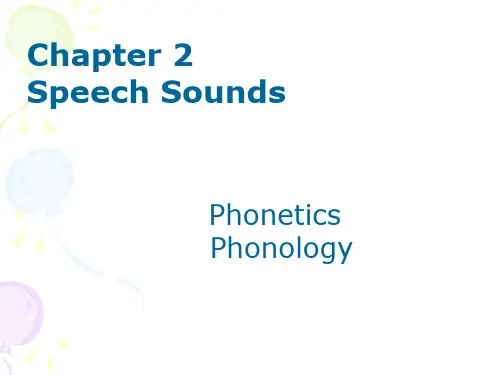

A New Seaghsounds of spoken English≠letters of written English↓InternationalPhonetic Alphabet →IPAIPA is a standardized and internally accepted system of phonetic transcription.Its basic principle is using a different letter for each distinguishable speech sounds. With minor modification it is now still used by phoneticians and linguists.The International Phonetic Alphabet (Revised to 2005)only some of the sounds →units in the language system.study from various perspectives ↓PhoneticsPhonologyPhonetics -studies how speech sounds are produced, transmitted, and perceived.Articulatory Phonetics- the study of the production of speech sounds.Acoustic Phonetics- the study of the physical properties of speech sounds. Perceptual or Auditory Phonetics - concerned with the perception of speech sounds.- the study of the sound patterns and sound systems of languages. Aim- discover the principles that govern the way sounds are organized in languages, and to explain the variations that occur.1- analyze an individual language, say English, in order to determine itsphonological structure, i.e. whichsound units are used and how they are put together.2- compare the properties of sound systems in different languages in order to make hypotheses about the rulesthat underlie the use of sounds inthem, and3- ultimately discover the rules that underlie the sound patterns of alllanguages.nasal cavityoral cavitypharyngealcavityThe three resonating cavitiesSpeech Organs 1.lips 2.teeth 3.teeth ridge (alveolar) 4.hard palate 5.soft palate (velum) 6.uvula 7.tip of the tongue 8.blade of the tongue 9.front of the tongue 10.back of the tongue11.vocal cords1 2 1 234 567 8 910 11MouthConsonants are produced ‘by a closure in the vocal tract, or by a narrowing which is so marked that air cannot escape without producing audible friction’.By contrast, a vowel is produced without such ‘stricture’ so that ‘air escapes in a relatively unimpeded way through the mouth or nose’.The distinction between vowels and consonants lies in the obstruction of airstream.As there is no obstruction of air in the production of vowels, the description of the consonants and vowels cannot be done along the same lines.The place of articulation refers to the point where a consonant is made.Consonants - any place between the lips and the vocal folds.Bilabial双唇音*[w] tongue body raises to velum →labia-velar[f], [v]Upper teeth & Lower lip 唇齿音[ð], [θ]Tongue tip/blade & teeth 齿音[t], [d], [s], [z], [n], [l] , [ ]tongue tip/blade&alveolar ridge齿龈音[ſ],[3],([tſ],[d3])tongue tip&back of the alveolar ridge 后齿龈音[j][k], [g], [η], [w] [h] Palatal 硬腭音Velars 软腭音Glottal 声门音[ ] - 书[ u] [ ][ ] [ ] Retroflex 卷舌音Uvular 小舌音Pharyngeal喉音Place of Articulation Bilabial [p], [b], [m], [w] Labiodental [f], [v]Dental [ð], [θ]Alveolar [t], [d], [s], [z], [n], [l], Post-alveolar [ſ], [3],Palatal [j]Velar [k], [g], [η], [w] Glottal [h]RetroflexUvularPharyngealComplete closure(articulators)→ airstreamcannot escapethrough themouth.1.Closing phasepression3.release [p], [b], [k], [g], [t], [d]爆破音(plosive)Most sounds are produced orally, with the velum raised, preventing air flow from entering the nasal cavity. However, when the velum is lowered and the airstream is allowed to flow out through the nose to produce sounds -nasals. [m][n][η]鼻音air stream partially obstructed and turbulent airflow is produced [f], [v] [ð], [θ] [s], [z] [ſ], [3] [h]摩擦音one articulator is close to another, but without the vocal tract being narrowed for turbulent air stream[w][j]无摩擦延续音(半元音)obstruction in the incomplete closure between one or both sides of the tongue and the roof of the mouth [l]边音塞擦音a stop followedimmediately by africativean articulator is set vibrating by the airstream [r] ( )颤音only one vibration is produced [ ]触音/闪音[p] [b] [f] [v] [m] Voiceless bilabial stopVoiced bilabial stopVoiceless labiodental fricative Voiced labiodental fricative Bilabial nasal。
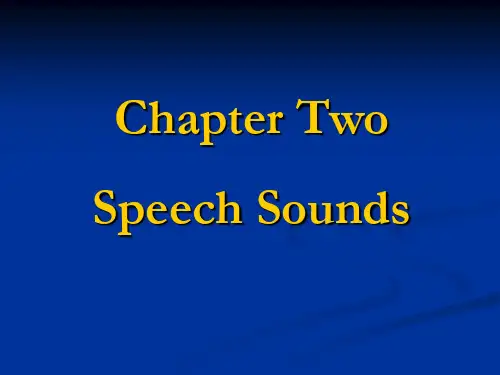
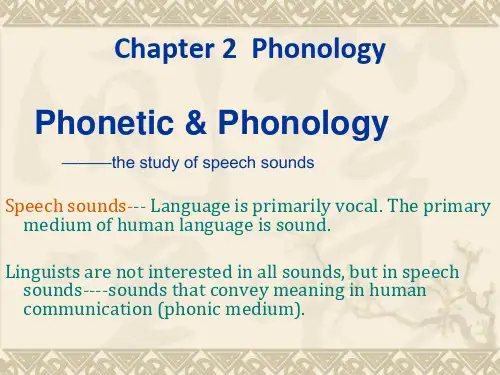
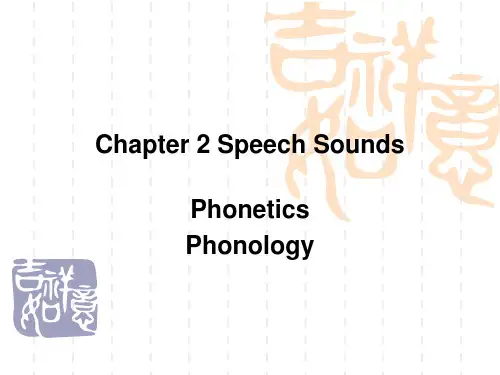
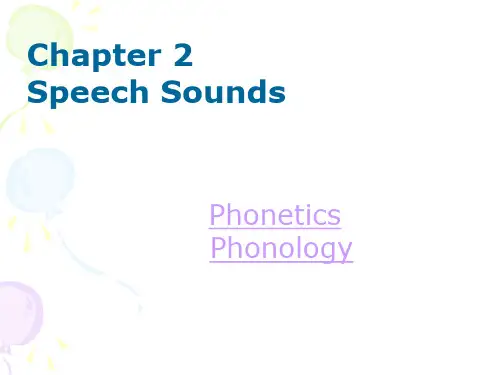
Chapter Two Speech Sounds--------Phonetics and PhonologyPart One Phonetics1. Phonetics i s the study of sounds, which occur in the world’s language. It studies the characteristics of speech sounds.2. Speech organs are the human body involved in the production of speech, including the lungs, the trachea, the throat, the nose and the The pharynx, mouth, and nose form the three cavities of the vocal tract(声道).3. Divergence means the English spelling does not represent its pronunciation.Why?Reasons:1> Different letters may represent the same sound; 2> A single letter may represent different sounds. 3> Some letters do not represent any sound at all.4.IPA( International Phonetic Alphabet) is a standard set of symbols for transcribing the sounds of any world’s language.P295. Consonants and VowelsIn describing sounds, a basic distinction is made between consonants and vowels.1> There is an obstruction of airstream at some point of the vocal tract in producing consonants2> Consonants can be studied from two angles( aspects), Manner of Articulation and Place of Articulation.According to the manner of articulation(发音方式),the consonants can be divided into the following six kinds.(1) Stops: [p,b],[t,d],[k,g](2) Fricatives(擦音): [s,z], [θ, ð ],[∫,З],[f,v].[h](3) Affricates(塞擦音): [t∫,dЗ](4) Nasals:[m,n, η](5) Laterals(边音):[l](6) Approximants(通音):[r,w,j]According to the place of articulation(发音位置),the consonants can be divided into the following eight kinds.(1)Bilabial(双唇音):[p,b],[m],[w](2)Labial-dental(唇齿音): [f,v](3)Detal(齿音):[f,v](4)Alveolar(齿龈音):[t,d],[s,z],[n],[r],[l](5)Velar(软腭音):[k,g],[η](6)Glottal(声门音):[h](7)Palatal(硬腭音):[j](8)Postalveolar(后齿龈音): [∫,З]3>There is no obstruction of air stream in producing vowels. No articulators come very close together and the airstream passes through the vocal tract.By convention, the eight primary cardinal vowels include:[i],[e],[ε], [æ],[u],[o], [ɔ],[а]V owels can studied from the following four angles.①Part of the tongue that is raised------front,center, back②the height of the tongue------high, middle, low③the shape of the lips------rounded, unrounded④the length of the sound------tense, laxPart Two From Phonetics to Phonology1.Coarticulation means the sound of language are greatly influenced by neighbouring sounds, including anticipatory coarticulation( the sound becomes more like the following sounds)(先期协同发音), and preservative coarticulation( the sound displays the influence of the former sound)(后滞协同发音).For example, in lamb, the vowel [æ] has some feature of the following nasal [m], then we call it anticipatory coarticulation. In map, the vowel [æ] is influenced by the former nasal [m], then we call it preservative coarticulation.Phonetic transcription contains two kinds of transcription, one is narrow transcription and the other broad transcription.The narrow transcription tries to show all the possible speech sounds, including the minutest parts of pronunciation. The IPA chart has a set of diacritics for the purpose of transcribing the minute parts of pronunciation.2. PhonologyPhonetics studies the physical characters of speech sounds’production system, while phonology focuses on the linguistic patterns of speech sounds and how they are used to convey meaning in linguistic communication.1.PhonemeMinimal Pairs ------------PhonemeMinimal Pairs test is to take a word, replace one sound by another, and see whether to generate a different meaning.For example,tin[tin]--------replace [t] by [d]-------din[din]------ a different word results.①Then tin and din can be called minimal pairs.Minimal pairs: When two different phonetic forms are identical in every way except for one sound unit which occurs in the same place of the order, the two forms are supposed to form a minimal pair.②And [t] and [d] are important in English, because they enable us to distinguish tin from din, tie from die.Then these important units like [t] and [d] can be called phoneme. Phoneme is a phonological unit, and is the smallest unit that can distinguish one word from another.2. AllophonesA phone is a phonetic unit. The speech sounds we hear and produce during communication are all phones(音子). The different phones representing a phoneme in different phonetic environment are called this phoneme’s allophones.For example,peak-----BT-----/pi:k/-----NT---aspirated--[phi:k]speak---BT----/spi:k/----NT---unaspirated--[spi:k][p,ph] are two different phones and are variants of the phoneme/p/. Such variants of a phoneme are called allophones of the same phoneme.This phenomenon of variation in the pronunciation of phonemes in different positions is called allophony or allophonic variation. In this phenomenon, the allophones are said to bein complementary distribution(互补分布)because they never occur in the same context: [p] occurs after [s] while [ph] occurs in other places.3. Phonological Process1> Assimilation It refers to the process by which a sound becomes similar to the neighboring sound. For example,five past------[faivpa:st]------[faifpa:st]has to ------[h æztu:]-------[h æstu:]You can[η] go now.2> Epenthesis(增音) An interesting case is the indefinite article a/an in English. Examples: a boy, a girl, a hotel, a yellow hatan apple, an honor, an orange hat--------It is the lack of a consonant between vowels. Then inserting a nasal[n] bwtween them.3> Suprasegmentals(超音段特征) Suprasegmental features refers to the characters of linguistic units larger than phoneme, including stress, tone, and intonation.①SyllableIt is an important unit in the study of suprasegments. In can be classified into two types, monosyllable, like cat and pen, and polysyllable, like computer and festival.A syllable can be divided into onset(节首),nucleus(节核,韵峰), and coda(节尾).For onset, it may be empty or filled by a cluster as many as three consonants, like sclaff[sklæf].For nucleus, it is a must for a syllable, and is often the task of vowels.For coda, it may be empty or filled as many as four consonants, like sixths[siksθs ]. A syllable with a coda is called a closed syllable; a syllable without a coda is called an open syllable.Another analysis:nucleus+coda=rhyme(韵基)So also a syllable=onset+ rhyme②StressStress refers to the degree of force used in producing a syllable. In description, a raised vertical line[´]is often used just before the syllable.③Intonation(语调)Intonation refers to the occurrence of repeating fall-rise patterns, which have the respective meaning in it.。
语⾔学教案Chapter2SpeechSounds Chapter 2 Speech Sounds2.1 Speech production and perception2.2 Speech organs2.3 Segments, divergences, and phonetic transcription2.3.1 Segments and divergences2.3.2 Phonetic transcription2.4 Consonants2.4.1 Consonants and vowels2.4.2 Consonants2.4.3 Manners of articulation2.4.4 Places of articulation2.4.5 The consonants of English2.5 V owels2.5.1 The criteria of vowel description2.5.2 The theory of cardinal vowels2.5.3 V owel glides2.5.4 The vowels of RP2.6 Coarticulation and phonetic transcription2.6.1 Coarticulation2.6.2 Broad and narrow transcriptions2.7 Phonological analysis2.8 Phonemes and allophones2.8.1 Minimal pairs2.8.2 The phoneme theory2.8.3 Allophones2.9 Phonological processes2.9.1 Assimilation2.9.2 Phonological processes and phonological rules2.9.3 Rule ordering2.10 Distinctive features2.11 Syllables2.11.1 The syllable structure2.11.2 Sonority scale2.11.3 Syllabification and the maximal onset principle2.12 Stress2.1 Speech production and perceptionLanguage i s first and foremost a “system of vocal symbols”.Sound is prior to writing.Phonetics: the study of soundsPhonology: the study of sound patterns.Speech SpeechProduction Perception(Speaker A) (Speech B)●ARTICULATORY PHONETICS: the study of the production of speech sounds●ACOUSTIC PHNETICS: the study of physical properties of sounds produced in speech●AUDITORY PHONETIC: the study of perception of speech sounds2.2 Speech organsSPEECH ORGANS(or VOCAL ORGANS): parts of the human body involved in the production of speechLungTrachea(or windpipe)Throat: pharynx, larynxNoseMouth: tongue, parts of palateVOCAL TRACTAIRSTREAM: source of energyPulmonic & Non-pulmonicLARYNXV ocal folds, and ventricular foldsPositions of vocal folds●Apart: [p, s, t]●Close together: [b, z, d]●Totally together: glottal stopPHARYNXMOUTHUpper lip, upper teeth, alveolar ridge, hard palate, soft palate (velum), uvulaLower lip, lower teeth, tongue, mandible(lower jaw 下腭)TONGUE:tip, blade, front, back, root2.3 Segments, divergences, and phonetic transcription2.3.1 Segments and divergencesSEGMENTE.g. above(“e” is silent)QUESTION: Why divergence between sound and symbol?2.3.2 Phonetic transcriptionQuestions: Why do we need phonetic transcription?International Phonetic Alphabet2.4 Consonants2.4.1 Consonants and vowelsCONSONATNS are produced by constricting or obstructing the vocal tract at some place to divert, impede, or completely shut off the flow or air in the oral cavity.VOWELS are produced without such obstruction so no turbulence or a total stopping of the air can be perceived.SEMI-VOWEL/SEMI-CONSONA TNT2.4.2 ConsonantsNOTE: In the production of consonants at least two articulators are involved. E.g. bad(a) MANNERS OF ARTICULATION(b) PLACES OF ARTICULATION2.4.3 Manners of articulation(1) STOP/POSITIVENASAL STOP (or NASAL): [m, n, ]ORAL STOP (or STOP): e.g. [p, b, t, d](2) FRICATIVE: [f, v, h](3) (MEDIAN) APPROXIMANT(4) LATERAL (APPROXIMANT): [l](5) OthersTRILL (or ROLL)TAP(or FLAP)AFFRICATIVEE.g. “ch-” in “church”2.4.4 Places of articulatio n(1) BILABIAL(2) LABIODENTAL(3) DENTAL: made by the tongue tip or blade and the upper front teeth, e.g. [ , ?]. (Onlyfricative are strict dental)INTERDENTAL(4) ALVEOLAR: made with the tongue tip or blade and the alveolar ridge(5) POSTALVEOLAR(6) RETROFLEX: “r” of red.(7) PALATAL(8) VERLAR: [k, g] in cat and get(9) UVULAR: rural Northern accent, “r” in try(10) PHARYNGEAL(11) GLOTTAL2.4.5 The consonants of EnglishReceived pronunciation (RP) (or BBC English, Oxford English)[p] voiceless bilabial stop[b] voiced bilabial stop[s] voiceless alveolar fricative2.5 V owels2.5.1 The criteria of vowel descriptionC.f. V owels vs. consonantsObstruction of airstreamCriteria of vowels:●The part of the tongue that is raised — front, center, or back●The extent to which the tongue rises in the direction of the palate — high, mid (mid-high andmid-low), low●The kind of opening made at the lips — various degrees of lip rounding or spreading●The position of the soft palate — raised for oral vowels, and lowered for nasalized vowels2.5.2 The theory of cardinal vowelsCardinal vowels (基本元⾳)1844 A. J. Ellis1867 A. M. Bell, Visible Speech1917 Daniel Jones, Outline of English Phonetics (1962)CARDIANL VOWELSCardinal vowel diagramSCHW A (中性元⾳): the tongue position for the neutral vowel [?] is neither high nor low and neither front nor back2.5.3 V owel glidesPURE VOWELS (or MONOPHTHONGS)VOWEL GLIDES●Diphthongs●Triphthongs2.5.4 The vowels of RPGeneral agreement on vowels despite minute differenceUnsettled issues:●Speaker’s accent and personal preference. E.g. [?] [е] in bed and peg; [aI] or [ΛI]●The length of a particular vowel may vary according to the context in which they occur.E.g. vowel before a voiced consonant﹥vowel before a voiceless consonantbead ﹥beat≈bidTense vowel & Lax vowel2.6 Coarticulation and phonetic transcription2.6.1 CoarticulationNOTE: Sounds continually show the influence of their neighbors.COARTICULATIONAnticipatory coarticulation: lampPerseverative coarticulatio n: map2.6.2 Broad and narrow transcriptionsDIACRITICSE.g. Nasalization:[a] in lamb has some quality of the following nasal is labeled as [?] BROAD TRANSCRIPTIONS NARROW TRANSCRIPTIONS2.7 Phonological analysisC.f. phonetics & phonologyPHONETICS: a branch of linguistics which studies how speech sounds are made, transmitted, and received; the study of all possible speech soundsPHONOLOGY: a branch of linguistics which studies the sound system of language; the study of the way in which speakers of a language systematically use a selection of these sounds in order to express meaning.PHONOLOGICAL STRUCTURE: which sound units are used and how they pattern2.8 Phonemes and allophones2.8.1 Minimal pairsT or F: All the sounds cause change in the meaning of a word.C.f. tin & dintin [tin] din [din]MIMIMAL PAIRSPHONEME: the smallest unit of sound in a language which can distinguish two wordsE.g. /p/, /t/, /e/2.8.2 The phoneme theory“phonème”: speech sound (Pp 57)NOTE: Languages differ in the selection of contrastive sounds.2.8.3 AllophonesPhonemic transcription: / /Phonetic transcription: [ ]C.f. peak vs. speakpeak [sp h i:k] speak [sp=i:k]PHONE : individual sounds as they occur in speech. E.g. [p=], [p h] are two different phones and variants of the phoneme /p/ ALLOPHONES (⾳位变体): the variants of a phonemeCOMPLMENTARY DISTRIBUTION(1) /p/ [p=] / [s] __________[p h] elsewhere(Note: “[s] _________ ” is the environment I which /p/ appears.)ALLOPHONY / ALLOPHONIC V ARIATIONPHONETIC SIMILARITYFREE V ARIANTS2.9 Phonological processes2.9.1 AssimilationEx.a. cap [kap] can [k?n]b. tap [tap] tan [t?n]ASSIMILATIONREGRESSIVE ASSIMILIATIONPROGRESSIVE ASSIMLIATONEx. a. pan [?] cake b. sun [?] glassesc. you can [?] keep themd. he can [?] go now(3) f, v; ,e; s, z; ?, ?, t?, d?DEVOCINGEx.a. five past [fa I vpa:st] [fa I fpa:st]b. love to [lΛvt?][lΛft?]2.9.2 Phonological processes and phonological rulesPHONOLOGICAL PROCESSES(4) /v/ [f]Voiced fricatives are transformed into voiceless fricatives before voiceless segments. voiced fricative voiceless/ ____________ voicelessPHONOLOGICAL RULE“/” : to specify the environment in which the change takes placeFocus bara. Nasalization rule[- nasal] [+ nasal]/ ___________ [+ nasal]b. Dentalization rule[- dental] [+ dental]/ ___________ [+ dental]c. Velarlization rule[- velar] [+ velar]/ ___________ [+ velar]EPENTHESISE.g. a. a hotel, a boy, a wagon, a white houseb. an apple, an honour, an orange curtain, an old ladyNOTE: it is the lack of a consonant that requires the nasal [n] to be added to thee article a.(5) ? [n] / [?] __________ V2.9.3 Rule orderingEx.a. desk [dεsk] desks [dεsks]b. box [b ks]boxes[b ks?z]-(e)s: [s], [z], [?z]SIBILANTSTherefore:a.The /s/ appears after voiceless sounds.b.The /z/ appears after voiced sounds. (All vowels are voiced.)b.The /?z/ appears after sibilants.UNDERLYING FORM / UNDERLYING REPRESENTATION (UR)SURFACE FORM / SURFACE REPRESENTATION (SR)(6) z s / [-voice, C] ____________ (Devoicing)(7) ? ? / sibilant ___________ z (Epenthesis)Ex.a. //si:t + z//b. //bεd + z//c. //keIs + z//s N/A *s DevoicingN/A N/A N/A Epenthesissi:ts bεdz keIss Outputa. //si:t + z//b. //bεd + z//c. //keIs + z//N/A N/A ? Devoicings N/A N/A Epenthesissi:ts bεdz keIs?z OutputRULE ORDERING2.10 Distinctive featuresDISTINCTIVE FEATURESE.g. voiced obstruent [+voiced], voiceless obstruent [-voiced][+sonorant], [- sonorant][+ nasal], [- nasal]2.11 SyllablesSUPRASEGMENTAL FEATURESLINEAR approach of phonologyNON-LINEAR approach / MULTI-LEVEL PHONOLOGY2.11.1 The syllable structurec.f. Chinese and English syllable structureChinese syllable structure: CVEnglish: MONOSYLLABIC(with one syllable) or POLYSYLLABIC(with more than one syllables) NUCLEUS/PEAK (核⼼/峰): vowel or consonanttable [teibl]:[tei], [bl]RHYME (or RIME) (韵基), ONSET (节⾸)NUCLEUS (核⼼): the vowel within the rhymeCODA (节尾): the consonant(s) after the nucleusσO(nset) R(hyme)N(cleus) Co(da)k l a s pEnglish syllable: (((C)C)C)V((((C)C)C)C)Chinese syllable: (C)V(C)2.11.2 Sonority scale(17) Sonority scale:Most sonorous 5 V owels4 Approximants3 Nasals2 Fricatives1 Stops(18) 5 *4 *32 *1 * *k l a s pThe sonority of each sound gradually rises to a peak at the nucleus and then falls at the coda.2.11.3 Syllabification and the maximal onset principleQUESITION: How to separate polysyllables?Country [kΛntri]*[kΛ.ntri], *[kΛntr.i]*[ntri], *[ kΛntr][kΛn.tri]MAXIMAL ONSET PRINCIPLE: when there is a choice as to where to place a consonant, it is put into the onset rather than the coda2.12 StressSTRESS refers to the degree of force used in producing a syllable. [']normal: inTEGral, forMIDableconservative: INtegral, FORmidablePR: laBORatory, DEBris, GARage,。
A New Seaghsounds of spoken English≠letters of written English↓InternationalPhonetic Alphabet →IPAIPA is a standardized and internally accepted system of phonetic transcription.Its basic principle is using a different letter for each distinguishable speech sounds. With minor modification it is now still used by phoneticians and linguists.The International Phonetic Alphabet (Revised to 2005)only some of the sounds →units in the language system.study from various perspectives ↓PhoneticsPhonologyPhonetics -studies how speech sounds are produced, transmitted, and perceived.Articulatory Phonetics- the study of the production of speech sounds.Acoustic Phonetics- the study of the physical properties of speech sounds. Perceptual or Auditory Phonetics - concerned with the perception of speech sounds.- the study of the sound patterns and sound systems of languages. Aim- discover the principles that govern the way sounds are organized in languages, and to explain the variations that occur.1- analyze an individual language, say English, in order to determine itsphonological structure, i.e. whichsound units are used and how they are put together.2- compare the properties of sound systems in different languages in order to make hypotheses about the rulesthat underlie the use of sounds inthem, and3- ultimately discover the rules that underlie the sound patterns of alllanguages.nasal cavityoral cavitypharyngealcavityThe three resonating cavitiesSpeech Organs 1.lips 2.teeth 3.teeth ridge (alveolar) 4.hard palate 5.soft palate (velum) 6.uvula 7.tip of the tongue 8.blade of the tongue 9.front of the tongue 10.back of the tongue11.vocal cords1 2 1 234 567 8 910 11MouthConsonants are produced ‘by a closure in the vocal tract, or by a narrowing which is so marked that air cannot escape without producing audible friction’.By contrast, a vowel is produced without such ‘stricture’ so that ‘air escapes in a relatively unimpeded way through the mouth or nose’.The distinction between vowels and consonants lies in the obstruction of airstream.As there is no obstruction of air in the production of vowels, the description of the consonants and vowels cannot be done along the same lines.The place of articulation refers to the point where a consonant is made.Consonants - any place between the lips and the vocal folds.Bilabial双唇音*[w] tongue body raises to velum →labia-velar[f], [v]Upper teeth & Lower lip 唇齿音[ð], [θ]Tongue tip/blade & teeth 齿音[t], [d], [s], [z], [n], [l] , [ ]tongue tip/blade&alveolar ridge齿龈音[ſ],[3],([tſ],[d3])tongue tip&back of the alveolar ridge 后齿龈音[j][k], [g], [η], [w] [h] Palatal 硬腭音Velars 软腭音Glottal 声门音[ ] - 书[ u] [ ][ ] [ ] Retroflex 卷舌音Uvular 小舌音Pharyngeal喉音Place of Articulation Bilabial [p], [b], [m], [w] Labiodental [f], [v]Dental [ð], [θ]Alveolar [t], [d], [s], [z], [n], [l], Post-alveolar [ſ], [3],Palatal [j]Velar [k], [g], [η], [w] Glottal [h]RetroflexUvularPharyngealComplete closure(articulators)→ airstreamcannot escapethrough themouth.1.Closing phasepression3.release [p], [b], [k], [g], [t], [d]爆破音(plosive)Most sounds are produced orally, with the velum raised, preventing air flow from entering the nasal cavity. However, when the velum is lowered and the airstream is allowed to flow out through the nose to produce sounds -nasals. [m][n][η]鼻音air stream partially obstructed and turbulent airflow is produced [f], [v] [ð], [θ] [s], [z] [ſ], [3] [h]摩擦音one articulator is close to another, but without the vocal tract being narrowed for turbulent air stream[w][j]无摩擦延续音(半元音)obstruction in the incomplete closure between one or both sides of the tongue and the roof of the mouth [l]边音塞擦音a stop followedimmediately by africativean articulator is set vibrating by the airstream [r] ( )颤音only one vibration is produced [ ]触音/闪音[p] [b] [f] [v] [m] Voiceless bilabial stopVoiced bilabial stopVoiceless labiodental fricative Voiced labiodental fricative Bilabial nasal。